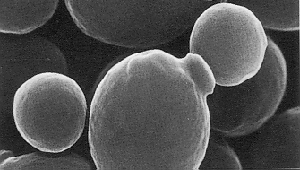Saccharomyces cerevisiae a.k.a Budding/Baker’s/Brewer’s Yeast
by
Yeast, specifically Saccharomyces cerevisiae, have had a tremendous impact on not only the scientific community but on the greater world. The initial scientific studies in yeast lead to the birth of modern chemistry, microbiology and biochemistry. Also, the next time you enjoy an ice cold beer or savor a delicious piece of bread, thank these little guys for their many contributions to the world.
History of Yeast
Unlike higher eukaryote model organisms, yeast had to be established as living organisms before they could be used as a model organism. Early in the nineteenth century, the existence of living microbes was a matter of debate. By studying yeast as the cause of fermentation, scientists recognized them as microorganisms and began to characterize them.
Chemists, not biologists, conducted the first scientific studies of alcohol fermentation. Antoine Lavoisier, one of the founders of modern chemistry, was a pioneer. He described the phenomenon of alcoholic fermentation as ‘one of the most extraordinary in chemistry’ and estimated the proportions of the elements in sugar, water, and yeast paste. By the second half of the nineteenth century, Louis Pasteur proved that alcoholic fermentation was a microbial occurrence. Pasteur wrote ‘…we see that the yeast takes something from the sugar…’ and declared indisputably that alcoholic fermentation is a physiological process. By 1894, Emil Fisher’s study of sugar utilization by yeast generated an understanding of enzyme specificity and the nature of enzyme-substrate complexes.
The Awesome Power of Yeast
S. cerevisiae has been the model system for molecular genetic research because the basic cellular mechanics of replication, recombination, cell division and metabolism are generally conserved between yeast and larger eukaryotes, including mammals. The complete sequence of its genome has proved to be extremely useful as a reference towards the sequences of human and other higher eukaryotic genes. Furthermore, the ease of genetic manipulation of yeast allows its use for conveniently analyzing and functionally dissecting gene products from other eukaryotes.
Direct Transformation
Unique to yeast in model organism studies, synthetic oligonucleotides can be directly transformed into yeast allowing for easy production of altered forms of proteins. These techniques have been extensively used in the analysis of gene regulation, structure-function relationships of proteins, chromosome structure, and other general questions in cell biology.
Homologous Recombination
Yeast have the unique ability to recombine exogenous DNA (with partial homologous segments) directly to the specific location of your choice their genome. High rates of gene conversion coupled with homologous recombination in yeast have led to the development of techniques for direct replacement of genetically engineered DNA sequences into their normal chromosome locations.
Why yeast are so easy to work with:
1. Same technical advantages of Escherichia coli that permit rapid progress in the lab — rapid growth, dispersed cells, ease of replica plating and mutant isolation
2. A well defined genetic system
3. Highly versatile DNA transformation system
4. Can be handled with few safety measures. No special safety equipment required.
5. Remarkably inexpensive compared to higher eukaryote organisms.
6. Smells nice. No nasty bacterical smell! More like baking bread…
7. Can easily freeze and store at -80°C for later use
Downside to working with yeast:
Yeast are susceptible to bacterial contamination so they must be kept separate from E. coli. Generally, there are dedicated incubators for yeast in the lab.
Short list of techniques utilizing yeast:
1. Gene cloning
2. Genetic engineering
3. Protein Engineering via Directed Evolution
3. Two-hybrid screening for the general detection of protein-protein interactions
4. Protein expression systems for laboratory and commercial preparation of heterologous proteins.
Yeast are Super Cool!
Yeast are basically “large E. coli” with cellular process more similar to us than to bacteria. They are extremely easy to work with in the lab. The types of experiments you can do with them are endless. I consider S. cerevisiae to be a “Master of all Trades”. They can help conduct scientific research and make bread, beer, and other food stuffs. Can a mouse, fish, or fly do that?
_________________________________________________________
Leslie is a 6th year graduate student in the Chemistry and Chemical Biology graduate program at University of California, San Francisco. When not in the lab, she enjoys life with her husband, George, and 1 year old son, Thomas. Her other passions include cooking and photography.
_________________________________________________________
References:
Barnett, JA “Beginnings of microbiology and biochemistry: the contribution of yeast research” Microbiology (2003), 149, 557-567
F. Sherman, Yeast genetics. The Encyclopedia of Molecular Biology and Molecular Medicine, pp. 302-325, Vol. 6.
Saccharomyces Genomic Information Resource
________________________________________________________
See other articles in the series:
Drosophila melanogaster- The fruit fly.
Research’s Next Top Model (Zebrafish)
Getting to Know Your Worms (C. elegans)
The Almighty Fungi: The Revolutionary Neurospora crassa
We’re Gonna Need a Bigger Lab: Large Animal Models in Research
Tetrahymena: Little Creature, Big Discoveries
.



Chromo
wrote on December 26, 2011 at 2:00 pm
Hi,I wanted to know is nutrient defeiciency the reason for filamenation in Saccharomyces cerevisiae,?
Is there any media that promotes filamentaion but not sporulation (SLAD media causes both)